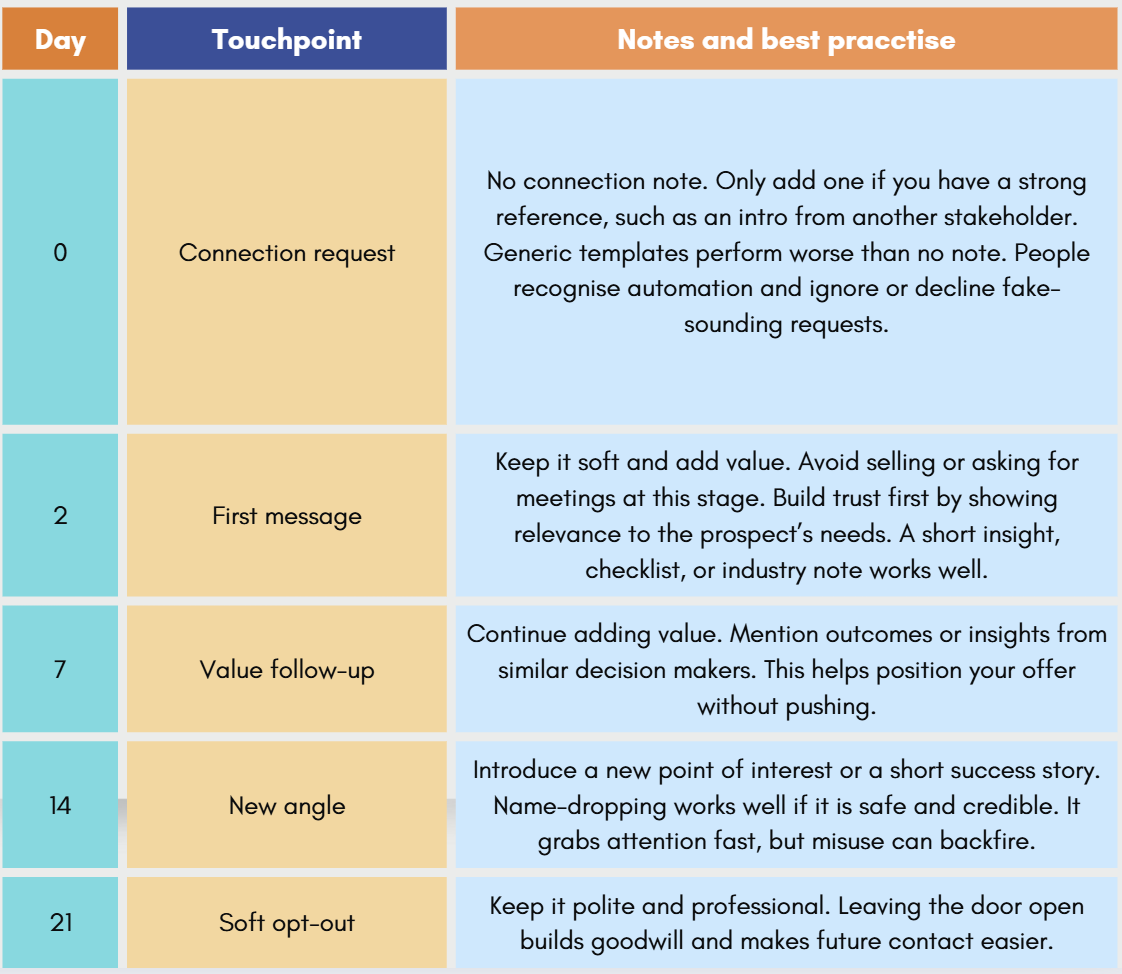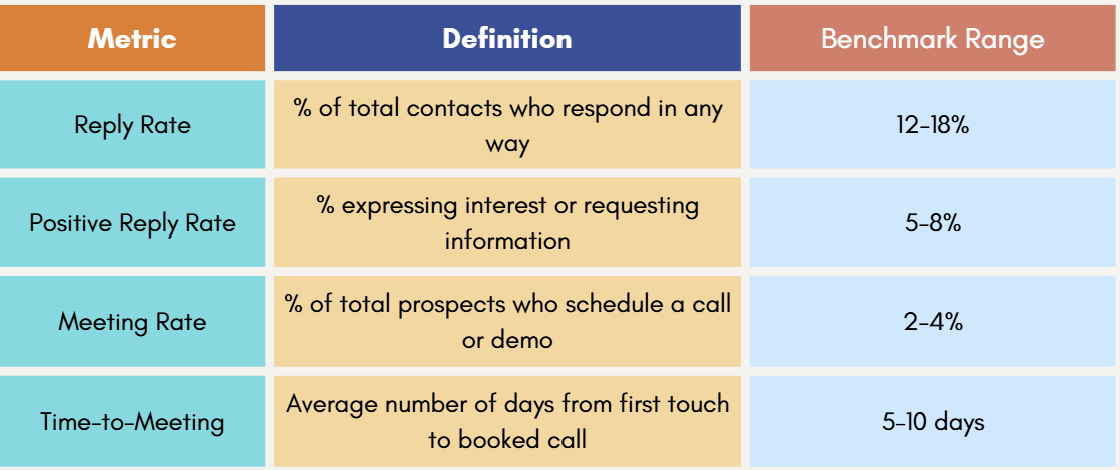Prospecting that converts: turn LinkedIn messages into meetings
By Aleena Kulsoom, Campaign Operations Manager at Accelera
You have just sent your 20th connection request this week. The message is polite, your pitch is brief, and yet, you get nothing in return. Not a single reply.
If this sounds familiar, you are not alone.
Most LinkedIn messages today never make it past “Seen.” In fact, the average cold outreach response rate sits between 10–15%, according to HubSpot and LinkedIn’s State of Sales 2024 report.
That’s the modern challenge of prospecting. Finding and qualifying right prospects to start real sales conversations doesn’t come from firing off a thousand hopeful DMs.
The methods have changed:
Outreach volume on LinkedIn has almost doubled since 2020, making it harder than ever to stand out.
While tools may make sending messages easier, authenticity suffers when every message reads the same.
So, what separates the ignored messages from the ones that turn into meetings? It’s the method. The best prospectors treat LinkedIn like a conversation platform instead of a billboard.
They measure performance the same way marketers track campaigns, including reply rate, positive reply rate, and meeting rate.
In this guide, we’ll take a look at how to build the kind of system.
Framework
You don’t need to spend half an hour studying every lead before hitting “Send.” Accelera’s campaigns show that three minutes of focused research per prospect can significantly increase reply rates. Here are some key lessons:
Focus on building small, targeted lists of potential customers instead of chasing volume. Authenticity is the best practice for effective prospecting. The goal is not to contact everyone, but to find the right prospects who are a good fit for your product or service.
Create mini lists of selected companies or decision makers that fall within your target audience. A 1-to-few or 1-to-1 account-based approach works best. This allows sales teams to build genuine connections instead of relying on endless cold calls or cold emails that go nowhere.
Do a bit of account or industry research before the initial contact. Look for signs of activity or change within the company that might signal a good time to reach out, such as new funding, expansion, or recent press releases. Use that context to shape your message. It can be as simple as a short personalised snippet, a quick insight about their market, or even a dedicated landing page or content piece tailored to that company’s needs.
Whenever possible, reference something specific that shows you understand the prospect’s world. You can name-drop mutual contacts, industry peers, or shared clients, but only if it is safe to do so. Used well, it creates trust and credibility. Used carelessly, it can backfire.
This kind of outbound prospecting helps move people naturally through your sales funnel and sales pipeline. It lets you generate qualified leads, engage with potential buyers, and reach decision makers at the right time with messages that feel human, not scripted.
That is how successful prospecting starts; through focus, context, and genuine understanding of your prospect’s needs.
Qualification in DMs (who to pursue vs park)
Not every reply is a win, and not every ignored message is a loss. Effective prospecting means identifying ideal prospects, deciding which conversations to pursue, and which to drop early before wasting time (or goodwill). You’re moving people through a sales funnel and the goal is to engage the right people at the right time for efficient lead generation and finding your potential prospects.
Signals you should pursue:
Their job title shows that they are the decision makers or have a strong influence in the decision process.
They mention a pain point that aligns with what you solve, such as scaling pipelines, automating lead flow or improving security posture. Great footing to build a good relationship.
They engage with relevant content (your posts, industry updates, or a peer’s case study).
Signals you should park it
Their role doesn’t fit your target buyer persona, or they’re clearly vendor-locked.
They show low engagement or are in different industries, the one you don't serve.
When that happens, don’t burn the bridge. Just park politely.
“Appreciate your honesty, [Name]. If things change later, happy to reconnect down the line.” or “All good; I’ll let you focus on [their current priority]. Will touch base next quarter.”
Tag them in your CRM system with a “Revisit in 90 days” note. You’ll thank yourself later.
Cadence - from first touch to meeting in 21 Days
A good sales prospecting sequence should feel structured yet human. The aim is to move potential customers smoothly through your sales funnel without sounding automated. Keep the focus on qualified leads, timing, and relevance.
Framework for outbound prospecting
On the right hand side, you will find a framework your sales teams can use for outbound prospecting.
Key reminders
4 to 5 messages are enough. After that, move them to a “Revisit later” tag in your CRM.
Keep every message under 250 characters so it is easy to read on mobile.
Focus on potential buyers and decision makers who are a good fit for your offer.
Authenticity and timing are more powerful than high message volume.
Track engagement across your sales pipeline to identify the best ways to convert each prospect into a discovery call.
This structure keeps outreach personal and effective, helping you generate qualified leads and build trust with the right prospects.
Handling common replies
Getting a reply, any reply, for that matter, is progress. But what you do next determines whether it becomes a meeting or a dead end. Treat every response as a starting point for building relationships: acknowledge their context, and only push forward when you have a good reason. The key is to have short, context-aware responses ready for the objections you’ll hear most often.
“Not now / send info”
Reply - “Of course, here’s a short 2-page summary with quick ROI examples. When would be the time to review this together?”
Why it works: you respect their hesitation while keeping momentum.
“We already have a tool”
“Good to hear! Out of curiosity, what are you using for [process]? We’ve seen teams on [tool] hit scaling limits around X users. Wondering if you’ve run into that yet.”
Why it works: instead of arguing, you open a consultative discussion. Curiosity lowers defensiveness and creates space to position your solution as complementary or more scalable.
“Budget later”
“Totally fair. Shall I check back in [month/quarter]? Often, timing changes fast once sales pipeline planning restarts.”
Why it works: you stay respectful while anchoring a future touch point.
Metrics that matter
Once your LinkedIn prospecting cadence is live, tracking the right metrics helps you track progress and see what's working. A few key performance indicators will tell you whether your outreach is working or needs re-calibrating:
Some key metrics you should consider
If your numbers sit below these benchmarks, revisit targeting, research time, or message clarity even and tighten your alignment to your prospect’s pain points. Small tweaks like personalising openings or shortening messages can help improve outcomes.
You don’t need complex software to measure success either. A simple Google Sheet, HubSpot CRM dashboard, or LinkedIn Sales Navigator export works fine to track outreach, responses, and booked calls.
Mistakes to avoid
Even experienced prospectors fall into bad habits. Here are a few common traps to avoid:
Writing essays instead of quick, conversational openers. That's against best practice.
Dropping in obvious AI phrasing or overusing emojis.
Using fake personalisation (“I loved your recent post”) with no specific reference.
Adding too many links (LinkedIn’s algorithm deprioritise external URLs).
Ignoring time zones, which can make your message land at 3 a.m. their time. Shows you haven't really dug into prospect's world.
A good rule of thumb is that if your message can’t be skimmed in one scroll on mobile, it’s too long.
Expert Spotlight – Daria’s tips
Inside Accelera: real-world advice from a prospecting specialist
After running outreach for dozens of SaaS and cybersecurity clients, Daria Jarosz, Accelera’s Customer Success Operations Manager – Sales, has seen what works (and what doesn’t). Here are a few of her prospecting tips:
“1. Do your research and define your target audience, but don’t narrow it down so much that you miss opportunities. It’s better to be in the right sea, even if you’re surrounded by a shoal of the wrong fish, than to dive into a random ocean and hope for the best.
2. Use automation in the first stages. Nobody can send hundreds of manual messages a week on top of a full-time job. Or outsource it to a sales teams like ours. But the second a real person replies with interest, that’s the cue for your sales representatives to take over. Because only you can turn that spark into a genuine conversation and leave a good first impression.
3. Patience is everything for successful prospecting. About 50% of the people you reach out to won’t be the right fit. Of that 50%, around 20% will point you to someone who is, and of those, 10% will be in a meeting with you within days. That’s why you don’t just thank the 50% and move on.
4. LinkedIn isn’t the place for corporate scripts. People scroll here like they do on any social platform, so your outreach should feel like a conversation they’d actually want to have. You can reserve your email templates and formal tone for, well, email.””
Final thoughts
Modern LinkedIn prospecting requires relevance, rhythm, and timing. The teams turning their cold messages into meetings today aren’t sending more messages. They’re sending better ones with a strong prospecting mindset.
If your DMs sound like everyone else’s, they’ll perform like everyone else’s. But a few small changes in tone, timing, and targeting can completely transform your pipeline in a matter of days.
Ready to see what your outreach could do with expert eyes? Take the next step.





